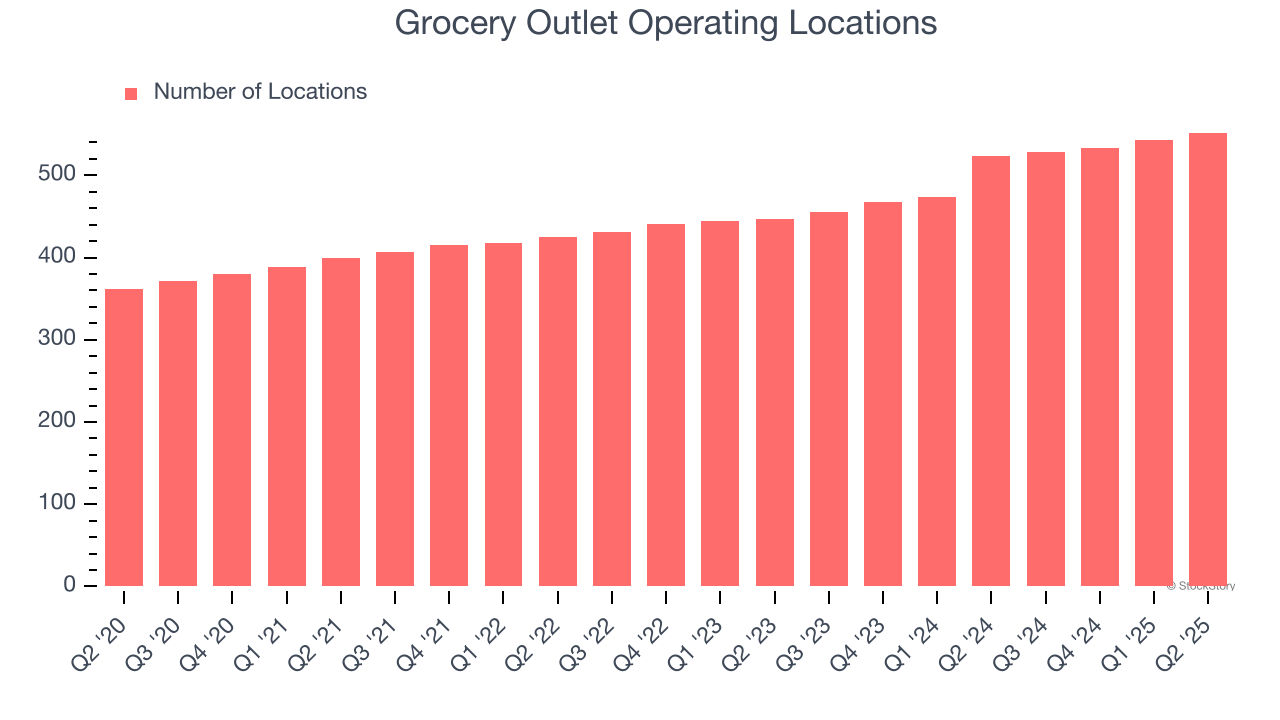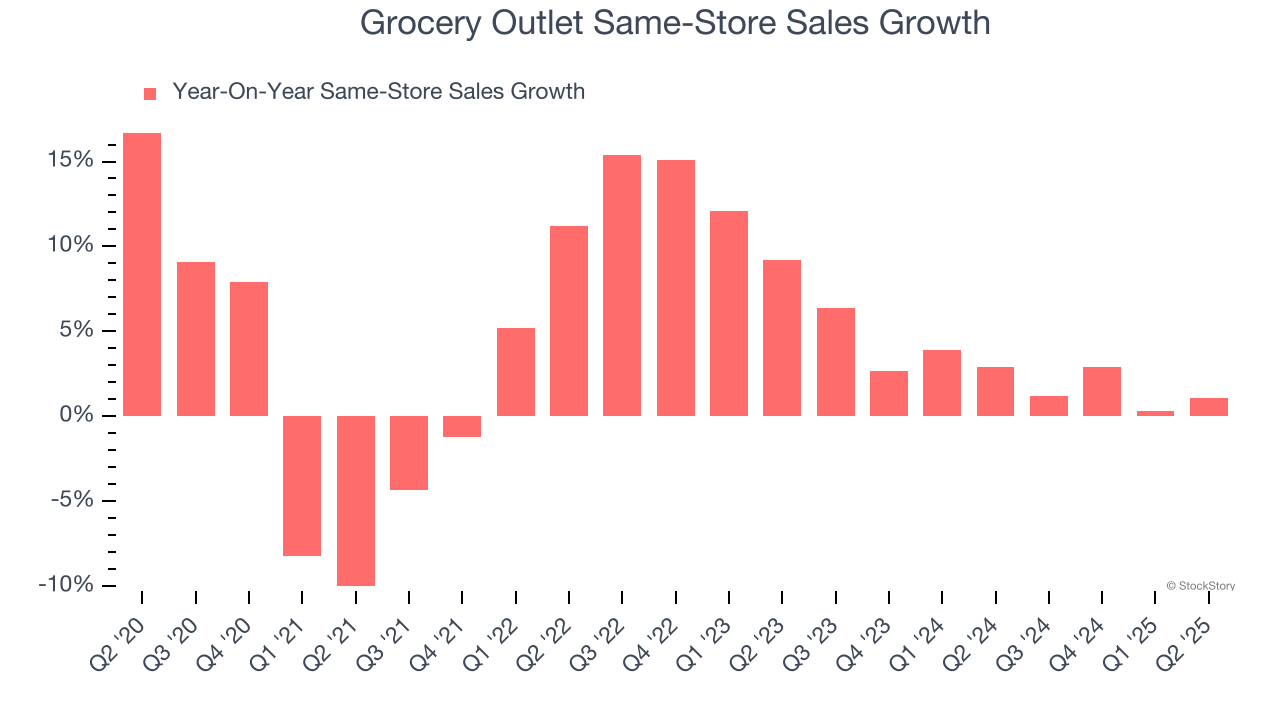
Discount grocery store chain Grocery Outlet (NASDAQ:GO) missed Wall Street’s revenue expectations in Q2 CY2025 as sales rose 4.5% year on year to $1.18 billion. On the other hand, the company’s full-year revenue guidance of $4.75 billion at the midpoint came in 0.8% above analysts’ estimates. Its non-GAAP profit of $0.23 per share was 32.9% above analysts’ consensus estimates.
Is now the time to buy Grocery Outlet? Find out by accessing our full research report, it’s free.
Grocery Outlet (GO) Q2 CY2025 Highlights:
- Revenue: $1.18 billion vs analyst estimates of $1.19 billion (4.5% year-on-year growth, 0.6% miss)
- Adjusted EPS: $0.23 vs analyst estimates of $0.17 (32.9% beat)
- Adjusted EBITDA: $67.75 million vs analyst estimates of $64.29 million (5.7% margin, 5.4% beat)
- The company reconfirmed its revenue guidance for the full year of $4.75 billion at the midpoint
- Management raised its full-year Adjusted EPS guidance to $0.78 at the midpoint, a 6.9% increase
- EBITDA guidance for the full year is $265 million at the midpoint, above analyst estimates of $262.7 million
- Operating Margin: 1.1%, down from 2.3% in the same quarter last year
- Free Cash Flow Margin: 1.2%, similar to the same quarter last year
- Locations: 552 at quarter end, up from 524 in the same quarter last year
- Same-Store Sales rose 1.1% year on year (2.9% in the same quarter last year)
- Market Capitalization: $1.32 billion
“Our focus on execution is beginning to deliver results, enabling us to outperform our outlook for the second quarter,” said Jason Potter, President and CEO of Grocery Outlet.
Company Overview
Due to its differentiated procurement and buying approach, Grocery Outlet (NASDAQ:GO) is a discount grocery store chain that offers substantial discounts on name-brand products.
Revenue Growth
Examining a company’s long-term performance can provide clues about its quality. Any business can have short-term success, but a top-tier one grows for years.
With $4.51 billion in revenue over the past 12 months, Grocery Outlet is a small retailer, which sometimes brings disadvantages compared to larger competitors benefiting from economies of scale and negotiating leverage with suppliers. On the bright side, it can grow faster because it has more white space to build new stores.
As you can see below, Grocery Outlet grew its sales at a decent 11% compounded annual growth rate over the last six years (we compare to 2019 to normalize for COVID-19 impacts) as it opened new stores and increased sales at existing, established locations.

This quarter, Grocery Outlet’s revenue grew by 4.5% year on year to $1.18 billion, falling short of Wall Street’s estimates.
Looking ahead, sell-side analysts expect revenue to grow 8.2% over the next 12 months, a slight deceleration versus the last six years. Still, this projection is commendable and indicates the market is forecasting success for its products.
Today’s young investors won’t have read the timeless lessons in Gorilla Game: Picking Winners In High Technology because it was written more than 20 years ago when Microsoft and Apple were first establishing their supremacy. But if we apply the same principles, then enterprise software stocks leveraging their own generative AI capabilities may well be the Gorillas of the future. So, in that spirit, we are excited to present our Special Free Report on a profitable, fast-growing enterprise software stock that is already riding the automation wave and looking to catch the generative AI next.
Store Performance
Number of Stores
A retailer’s store count influences how much it can sell and how quickly revenue can grow.
Grocery Outlet sported 552 locations in the latest quarter. Over the last two years, it has opened new stores at a rapid clip by averaging 10.7% annual growth, among the fastest in the consumer retail sector. This gives it a chance to scale into a mid-sized business over time.
When a retailer opens new stores, it usually means it’s investing for growth because demand is greater than supply, especially in areas where consumers may not have a store within reasonable driving distance.

Same-Store Sales
A company's store base only paints one part of the picture. When demand is high, it makes sense to open more. But when demand is low, it’s prudent to close some locations and use the money in other ways. Same-store sales is an industry measure of whether revenue is growing at those existing stores and is driven by customer visits (often called traffic) and the average spending per customer (ticket).
Grocery Outlet’s demand has been healthy for a retailer over the last two years. On average, the company has grown its same-store sales by a robust 2.7% per year. This performance gives it the confidence to meaningfully expand its store base.

In the latest quarter, Grocery Outlet’s same-store sales rose 1.1% year on year. This was a meaningful deceleration from its historical levels. We’ll be watching closely to see if Grocery Outlet can reaccelerate growth.
Key Takeaways from Grocery Outlet’s Q2 Results
We were impressed by how significantly Grocery Outlet blew past analysts’ EPS expectations this quarter. We were also glad its EBITDA outperformed Wall Street’s estimates. Looking ahead, full-year guidance was solid, with EBITDA guidance above and EPS guidance raised from the previously provided figure. Overall, we think this was a solid quarter with some key areas of upside. The stock traded up 10.7% to $14.40 immediately following the results.
Grocery Outlet may have had a good quarter, but does that mean you should invest right now? When making that decision, it’s important to consider its valuation, business qualities, as well as what has happened in the latest quarter. We cover that in our actionable full research report which you can read here, it’s free.
